HRM3007: Individual Performance-Related Pay and Employee Performance
VerifiedAdded on 2022/11/24
|9
|2705
|165
Report
AI Summary
This report provides a critical evaluation of individual performance-related pay (IPRP) and its impact on employee motivation and performance. The report begins by defining IPRP and its role in linking pay to performance, discussing its benefits such as employee retention and increased productivity. The main body analyzes the extent to which IPRP can stimulate higher performance levels, considering factors like consistency, individual differences, legal issues, income standards, organizational structure, and types of occupation. The report then explores circumstances where IPRP motivates employees effectively, such as purposeful hiring, competitive salaries, and growth opportunities. Conversely, it also examines situations where IPRP may not be as effective, including wrong perceptions of human assets, strategic inability, short-term mentalities, lack of appreciation, and difficulties in quantifying outcomes. The report concludes by summarizing the benefits of IPRP, emphasizing the importance of human resource strategies in enhancing employee and organizational success.

Hrm3007
Paraphrase This Document
Need a fresh take? Get an instant paraphrase of this document with our AI Paraphraser
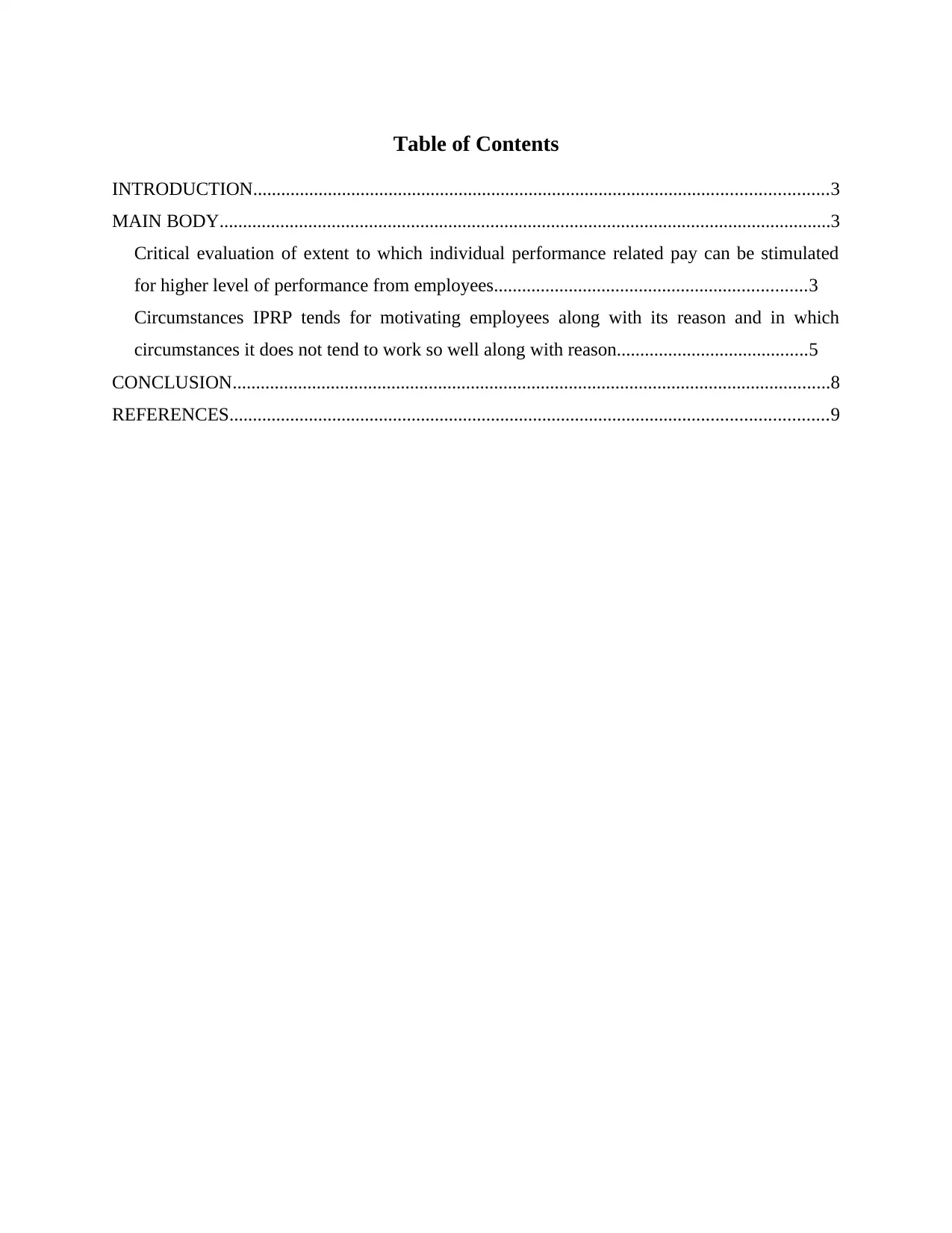
Table of Contents
INTRODUCTION...........................................................................................................................3
MAIN BODY...................................................................................................................................3
Critical evaluation of extent to which individual performance related pay can be stimulated
for higher level of performance from employees...................................................................3
Circumstances IPRP tends for motivating employees along with its reason and in which
circumstances it does not tend to work so well along with reason.........................................5
CONCLUSION................................................................................................................................8
REFERENCES................................................................................................................................9
INTRODUCTION...........................................................................................................................3
MAIN BODY...................................................................................................................................3
Critical evaluation of extent to which individual performance related pay can be stimulated
for higher level of performance from employees...................................................................3
Circumstances IPRP tends for motivating employees along with its reason and in which
circumstances it does not tend to work so well along with reason.........................................5
CONCLUSION................................................................................................................................8
REFERENCES................................................................................................................................9
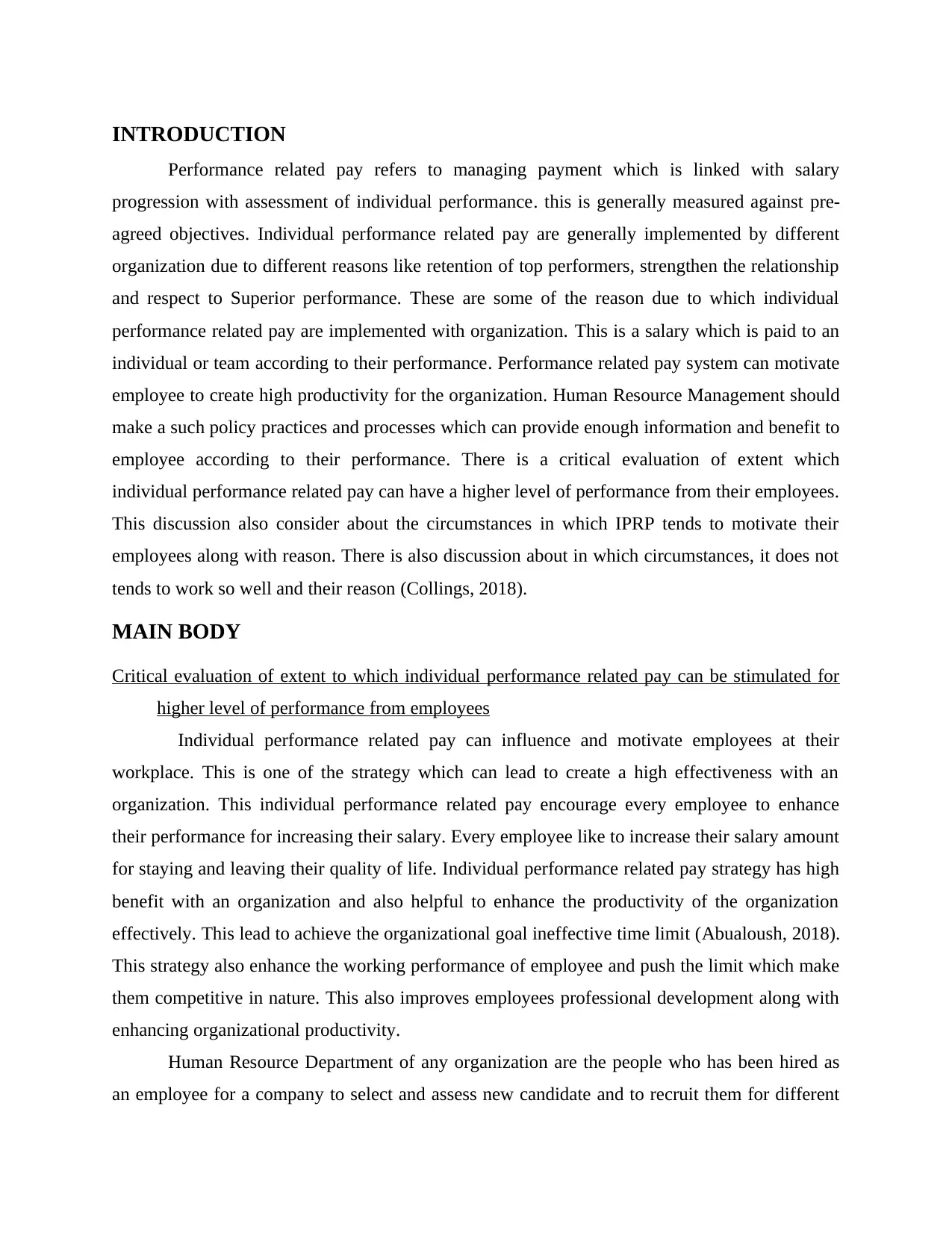
INTRODUCTION
Performance related pay refers to managing payment which is linked with salary
progression with assessment of individual performance. this is generally measured against pre-
agreed objectives. Individual performance related pay are generally implemented by different
organization due to different reasons like retention of top performers, strengthen the relationship
and respect to Superior performance. These are some of the reason due to which individual
performance related pay are implemented with organization. This is a salary which is paid to an
individual or team according to their performance. Performance related pay system can motivate
employee to create high productivity for the organization. Human Resource Management should
make a such policy practices and processes which can provide enough information and benefit to
employee according to their performance. There is a critical evaluation of extent which
individual performance related pay can have a higher level of performance from their employees.
This discussion also consider about the circumstances in which IPRP tends to motivate their
employees along with reason. There is also discussion about in which circumstances, it does not
tends to work so well and their reason (Collings, 2018).
MAIN BODY
Critical evaluation of extent to which individual performance related pay can be stimulated for
higher level of performance from employees
Individual performance related pay can influence and motivate employees at their
workplace. This is one of the strategy which can lead to create a high effectiveness with an
organization. This individual performance related pay encourage every employee to enhance
their performance for increasing their salary. Every employee like to increase their salary amount
for staying and leaving their quality of life. Individual performance related pay strategy has high
benefit with an organization and also helpful to enhance the productivity of the organization
effectively. This lead to achieve the organizational goal ineffective time limit (Abualoush, 2018).
This strategy also enhance the working performance of employee and push the limit which make
them competitive in nature. This also improves employees professional development along with
enhancing organizational productivity.
Human Resource Department of any organization are the people who has been hired as
an employee for a company to select and assess new candidate and to recruit them for different
Performance related pay refers to managing payment which is linked with salary
progression with assessment of individual performance. this is generally measured against pre-
agreed objectives. Individual performance related pay are generally implemented by different
organization due to different reasons like retention of top performers, strengthen the relationship
and respect to Superior performance. These are some of the reason due to which individual
performance related pay are implemented with organization. This is a salary which is paid to an
individual or team according to their performance. Performance related pay system can motivate
employee to create high productivity for the organization. Human Resource Management should
make a such policy practices and processes which can provide enough information and benefit to
employee according to their performance. There is a critical evaluation of extent which
individual performance related pay can have a higher level of performance from their employees.
This discussion also consider about the circumstances in which IPRP tends to motivate their
employees along with reason. There is also discussion about in which circumstances, it does not
tends to work so well and their reason (Collings, 2018).
MAIN BODY
Critical evaluation of extent to which individual performance related pay can be stimulated for
higher level of performance from employees
Individual performance related pay can influence and motivate employees at their
workplace. This is one of the strategy which can lead to create a high effectiveness with an
organization. This individual performance related pay encourage every employee to enhance
their performance for increasing their salary. Every employee like to increase their salary amount
for staying and leaving their quality of life. Individual performance related pay strategy has high
benefit with an organization and also helpful to enhance the productivity of the organization
effectively. This lead to achieve the organizational goal ineffective time limit (Abualoush, 2018).
This strategy also enhance the working performance of employee and push the limit which make
them competitive in nature. This also improves employees professional development along with
enhancing organizational productivity.
Human Resource Department of any organization are the people who has been hired as
an employee for a company to select and assess new candidate and to recruit them for different
⊘ This is a preview!⊘
Do you want full access?
Subscribe today to unlock all pages.

Trusted by 1+ million students worldwide
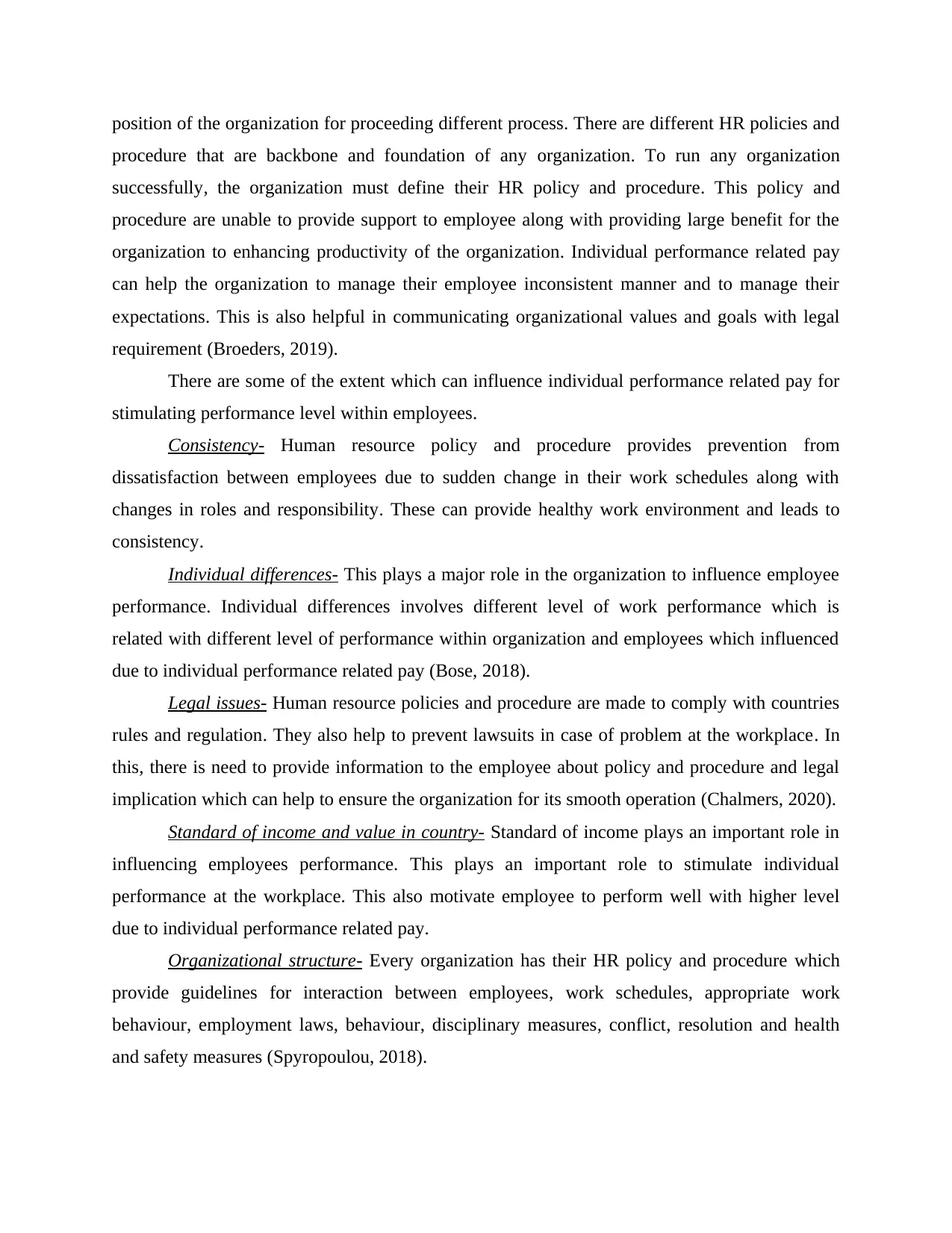
position of the organization for proceeding different process. There are different HR policies and
procedure that are backbone and foundation of any organization. To run any organization
successfully, the organization must define their HR policy and procedure. This policy and
procedure are unable to provide support to employee along with providing large benefit for the
organization to enhancing productivity of the organization. Individual performance related pay
can help the organization to manage their employee inconsistent manner and to manage their
expectations. This is also helpful in communicating organizational values and goals with legal
requirement (Broeders, 2019).
There are some of the extent which can influence individual performance related pay for
stimulating performance level within employees.
Consistency- Human resource policy and procedure provides prevention from
dissatisfaction between employees due to sudden change in their work schedules along with
changes in roles and responsibility. These can provide healthy work environment and leads to
consistency.
Individual differences- This plays a major role in the organization to influence employee
performance. Individual differences involves different level of work performance which is
related with different level of performance within organization and employees which influenced
due to individual performance related pay (Bose, 2018).
Legal issues- Human resource policies and procedure are made to comply with countries
rules and regulation. They also help to prevent lawsuits in case of problem at the workplace. In
this, there is need to provide information to the employee about policy and procedure and legal
implication which can help to ensure the organization for its smooth operation (Chalmers, 2020).
Standard of income and value in country- Standard of income plays an important role in
influencing employees performance. This plays an important role to stimulate individual
performance at the workplace. This also motivate employee to perform well with higher level
due to individual performance related pay.
Organizational structure- Every organization has their HR policy and procedure which
provide guidelines for interaction between employees, work schedules, appropriate work
behaviour, employment laws, behaviour, disciplinary measures, conflict, resolution and health
and safety measures (Spyropoulou, 2018).
procedure that are backbone and foundation of any organization. To run any organization
successfully, the organization must define their HR policy and procedure. This policy and
procedure are unable to provide support to employee along with providing large benefit for the
organization to enhancing productivity of the organization. Individual performance related pay
can help the organization to manage their employee inconsistent manner and to manage their
expectations. This is also helpful in communicating organizational values and goals with legal
requirement (Broeders, 2019).
There are some of the extent which can influence individual performance related pay for
stimulating performance level within employees.
Consistency- Human resource policy and procedure provides prevention from
dissatisfaction between employees due to sudden change in their work schedules along with
changes in roles and responsibility. These can provide healthy work environment and leads to
consistency.
Individual differences- This plays a major role in the organization to influence employee
performance. Individual differences involves different level of work performance which is
related with different level of performance within organization and employees which influenced
due to individual performance related pay (Bose, 2018).
Legal issues- Human resource policies and procedure are made to comply with countries
rules and regulation. They also help to prevent lawsuits in case of problem at the workplace. In
this, there is need to provide information to the employee about policy and procedure and legal
implication which can help to ensure the organization for its smooth operation (Chalmers, 2020).
Standard of income and value in country- Standard of income plays an important role in
influencing employees performance. This plays an important role to stimulate individual
performance at the workplace. This also motivate employee to perform well with higher level
due to individual performance related pay.
Organizational structure- Every organization has their HR policy and procedure which
provide guidelines for interaction between employees, work schedules, appropriate work
behaviour, employment laws, behaviour, disciplinary measures, conflict, resolution and health
and safety measures (Spyropoulou, 2018).
Paraphrase This Document
Need a fresh take? Get an instant paraphrase of this document with our AI Paraphraser
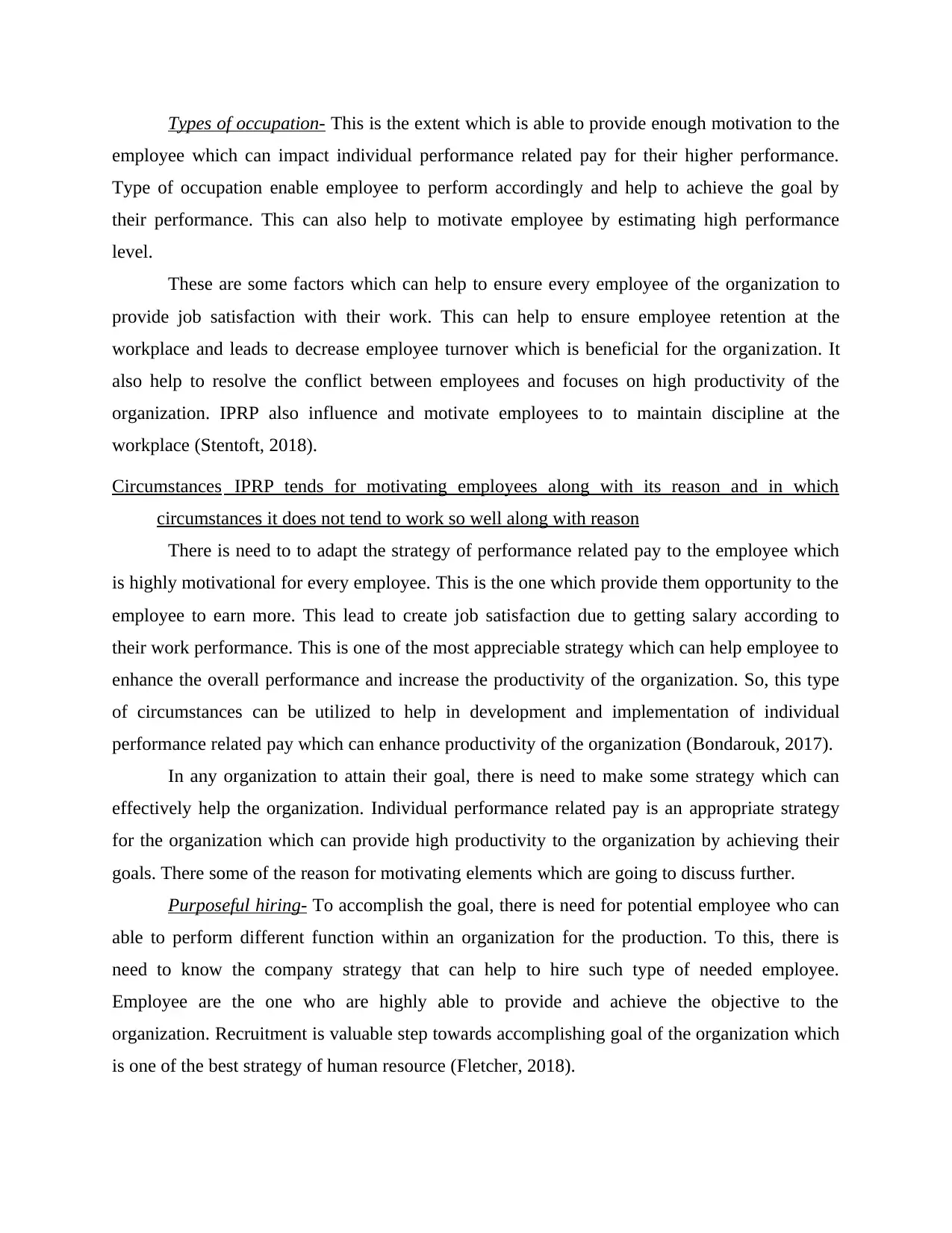
Types of occupation- This is the extent which is able to provide enough motivation to the
employee which can impact individual performance related pay for their higher performance.
Type of occupation enable employee to perform accordingly and help to achieve the goal by
their performance. This can also help to motivate employee by estimating high performance
level.
These are some factors which can help to ensure every employee of the organization to
provide job satisfaction with their work. This can help to ensure employee retention at the
workplace and leads to decrease employee turnover which is beneficial for the organization. It
also help to resolve the conflict between employees and focuses on high productivity of the
organization. IPRP also influence and motivate employees to to maintain discipline at the
workplace (Stentoft, 2018).
Circumstances IPRP tends for motivating employees along with its reason and in which
circumstances it does not tend to work so well along with reason
There is need to to adapt the strategy of performance related pay to the employee which
is highly motivational for every employee. This is the one which provide them opportunity to the
employee to earn more. This lead to create job satisfaction due to getting salary according to
their work performance. This is one of the most appreciable strategy which can help employee to
enhance the overall performance and increase the productivity of the organization. So, this type
of circumstances can be utilized to help in development and implementation of individual
performance related pay which can enhance productivity of the organization (Bondarouk, 2017).
In any organization to attain their goal, there is need to make some strategy which can
effectively help the organization. Individual performance related pay is an appropriate strategy
for the organization which can provide high productivity to the organization by achieving their
goals. There some of the reason for motivating elements which are going to discuss further.
Purposeful hiring- To accomplish the goal, there is need for potential employee who can
able to perform different function within an organization for the production. To this, there is
need to know the company strategy that can help to hire such type of needed employee.
Employee are the one who are highly able to provide and achieve the objective to the
organization. Recruitment is valuable step towards accomplishing goal of the organization which
is one of the best strategy of human resource (Fletcher, 2018).
employee which can impact individual performance related pay for their higher performance.
Type of occupation enable employee to perform accordingly and help to achieve the goal by
their performance. This can also help to motivate employee by estimating high performance
level.
These are some factors which can help to ensure every employee of the organization to
provide job satisfaction with their work. This can help to ensure employee retention at the
workplace and leads to decrease employee turnover which is beneficial for the organization. It
also help to resolve the conflict between employees and focuses on high productivity of the
organization. IPRP also influence and motivate employees to to maintain discipline at the
workplace (Stentoft, 2018).
Circumstances IPRP tends for motivating employees along with its reason and in which
circumstances it does not tend to work so well along with reason
There is need to to adapt the strategy of performance related pay to the employee which
is highly motivational for every employee. This is the one which provide them opportunity to the
employee to earn more. This lead to create job satisfaction due to getting salary according to
their work performance. This is one of the most appreciable strategy which can help employee to
enhance the overall performance and increase the productivity of the organization. So, this type
of circumstances can be utilized to help in development and implementation of individual
performance related pay which can enhance productivity of the organization (Bondarouk, 2017).
In any organization to attain their goal, there is need to make some strategy which can
effectively help the organization. Individual performance related pay is an appropriate strategy
for the organization which can provide high productivity to the organization by achieving their
goals. There some of the reason for motivating elements which are going to discuss further.
Purposeful hiring- To accomplish the goal, there is need for potential employee who can
able to perform different function within an organization for the production. To this, there is
need to know the company strategy that can help to hire such type of needed employee.
Employee are the one who are highly able to provide and achieve the objective to the
organization. Recruitment is valuable step towards accomplishing goal of the organization which
is one of the best strategy of human resource (Fletcher, 2018).

Benefit packages- To run an organization smoothly, there is high need to retain their
employee and their organization. This can be possible when organization is paying satisfactory
package and a different benefits packages to their employees. This benefits packages includes
sick pay, paid leave, pension contribution and different attractive offering which can provide
benefit to the employee. Such type of offering can attract employee and make their mind set to
stay in the organization. This create job satisfaction and motivate them enough to enhance their
performance within organization. This increased work performance is highly beneficial for the
organization to achieve their goal (Ocampo, 2018).
Competitive salary- This is also the strategy which enable employee to make them feel
valued, motivated and secure and provides increase productivity and retention rates. This is also
helpful in influencing employee to perform well which is due to having competitive salary and
enable them to enhance the productivity of the organization to achieve the organizational goal.
Competitive salary can influence employee to work effectively and provide them satisfaction
about their salary which can help in employee retention within organization (Ogbonnaya, 2018).
Growth opportunity- Every employee work for their growth which is their personal and
professional growth. So, human resource strategy need to made in such a manner that it can
allow the employee for their growth. This growth opportunity provide them motivation and
influence to enhance their work performance. This can lead to create increase in productivity of
the organization and help to achieve the organizational goal. This strategy is helpful for
employee retention within workplace and helps to reduce employee turnover within organization.
Frequent communication- In every organization, there is a need to frequent
communication with the employee which can make the coordination and interconnection with
every employee. This can provide help in sharing of information and reducing the
communication gap during delivery of any information for sharing of relevant information.
Frequent communication help to make decisions and increase the employee engagement. This
can help to motivate employees and enable them to share their thoughts and condition which is
beneficial for the organization. Such type of a strategy can lead to create a effective for the
organization and help to achieve organizational goal (Ferraris, 2019).
There are some of the circumstances in which individual performance related pay will not
tent to work so well and can impact the development and implementation of various human
resources strategies. These are going to be discussed further.
employee and their organization. This can be possible when organization is paying satisfactory
package and a different benefits packages to their employees. This benefits packages includes
sick pay, paid leave, pension contribution and different attractive offering which can provide
benefit to the employee. Such type of offering can attract employee and make their mind set to
stay in the organization. This create job satisfaction and motivate them enough to enhance their
performance within organization. This increased work performance is highly beneficial for the
organization to achieve their goal (Ocampo, 2018).
Competitive salary- This is also the strategy which enable employee to make them feel
valued, motivated and secure and provides increase productivity and retention rates. This is also
helpful in influencing employee to perform well which is due to having competitive salary and
enable them to enhance the productivity of the organization to achieve the organizational goal.
Competitive salary can influence employee to work effectively and provide them satisfaction
about their salary which can help in employee retention within organization (Ogbonnaya, 2018).
Growth opportunity- Every employee work for their growth which is their personal and
professional growth. So, human resource strategy need to made in such a manner that it can
allow the employee for their growth. This growth opportunity provide them motivation and
influence to enhance their work performance. This can lead to create increase in productivity of
the organization and help to achieve the organizational goal. This strategy is helpful for
employee retention within workplace and helps to reduce employee turnover within organization.
Frequent communication- In every organization, there is a need to frequent
communication with the employee which can make the coordination and interconnection with
every employee. This can provide help in sharing of information and reducing the
communication gap during delivery of any information for sharing of relevant information.
Frequent communication help to make decisions and increase the employee engagement. This
can help to motivate employees and enable them to share their thoughts and condition which is
beneficial for the organization. Such type of a strategy can lead to create a effective for the
organization and help to achieve organizational goal (Ferraris, 2019).
There are some of the circumstances in which individual performance related pay will not
tent to work so well and can impact the development and implementation of various human
resources strategies. These are going to be discussed further.
⊘ This is a preview!⊘
Do you want full access?
Subscribe today to unlock all pages.

Trusted by 1+ million students worldwide

Wrong perception of Human Assets- Due to having confusion regarding investment in
human asset and investment in technology and information which can create a wrong perception.
This can lead to create barrier in smooth process of the productivity of organization and can
impact development and implement of human resource strategy (Hearn, 2017).
Strategic inability- Human resource sometimes not able to think strategically which can
lead to create a difficulty in managing human resource and create inability to tackle different
issues regarding insufficient training and technical knowledge within an organization. This lead
to create difficulty in a development and implementation of Human Resource strategy within
organization.
Short-term mentality- It is one of the main barrier in development and implementation of
Human Resource strategy in which there is need to focus on long-term by the manager which can
help to establish long term objective for the organization.
Lack of appreciation- This is the barrier in which human resource strategy is not able to
identify the recognition of their employee which can lead to create difficulty in development and
implementation of HR strategy (García-Lillo, 2018). There is need to appreciate employee work
performance which can help them to boost and influence them to enhance their work
performance and increase organization productivity.
Difficulty and quantifying outcomes- When human resources strategies not able to
quantifying the outcome. Then it create difficulty in implementation and development of the
strategy within the workplace or organization.
Failure to understand the role- This is one of the barrier which fails to determine and
understand the role which can lead to understand the organizational process in effective way and
lead to create difficulty in development and implementation of human resource strategies.
Resistance- This is one of the main barrier which lead to create difficulty for implementing and
developing of Human Resource strategy. There is resistance in devleopment of new strategy and
their implementation which is due to establishing change within organization between work
schedule and working pattern (Chalmers, 2020).
Human Resource manager need to make the strategy and policy in such a manner that
they should provide the benefit to their employee along with organization. This is the one
through which employ an organization can support the development and implementation of
strategy which can help to increase the productivity and provide stability to the organization.
human asset and investment in technology and information which can create a wrong perception.
This can lead to create barrier in smooth process of the productivity of organization and can
impact development and implement of human resource strategy (Hearn, 2017).
Strategic inability- Human resource sometimes not able to think strategically which can
lead to create a difficulty in managing human resource and create inability to tackle different
issues regarding insufficient training and technical knowledge within an organization. This lead
to create difficulty in a development and implementation of Human Resource strategy within
organization.
Short-term mentality- It is one of the main barrier in development and implementation of
Human Resource strategy in which there is need to focus on long-term by the manager which can
help to establish long term objective for the organization.
Lack of appreciation- This is the barrier in which human resource strategy is not able to
identify the recognition of their employee which can lead to create difficulty in development and
implementation of HR strategy (García-Lillo, 2018). There is need to appreciate employee work
performance which can help them to boost and influence them to enhance their work
performance and increase organization productivity.
Difficulty and quantifying outcomes- When human resources strategies not able to
quantifying the outcome. Then it create difficulty in implementation and development of the
strategy within the workplace or organization.
Failure to understand the role- This is one of the barrier which fails to determine and
understand the role which can lead to understand the organizational process in effective way and
lead to create difficulty in development and implementation of human resource strategies.
Resistance- This is one of the main barrier which lead to create difficulty for implementing and
developing of Human Resource strategy. There is resistance in devleopment of new strategy and
their implementation which is due to establishing change within organization between work
schedule and working pattern (Chalmers, 2020).
Human Resource manager need to make the strategy and policy in such a manner that
they should provide the benefit to their employee along with organization. This is the one
through which employ an organization can support the development and implementation of
strategy which can help to increase the productivity and provide stability to the organization.
Paraphrase This Document
Need a fresh take? Get an instant paraphrase of this document with our AI Paraphraser
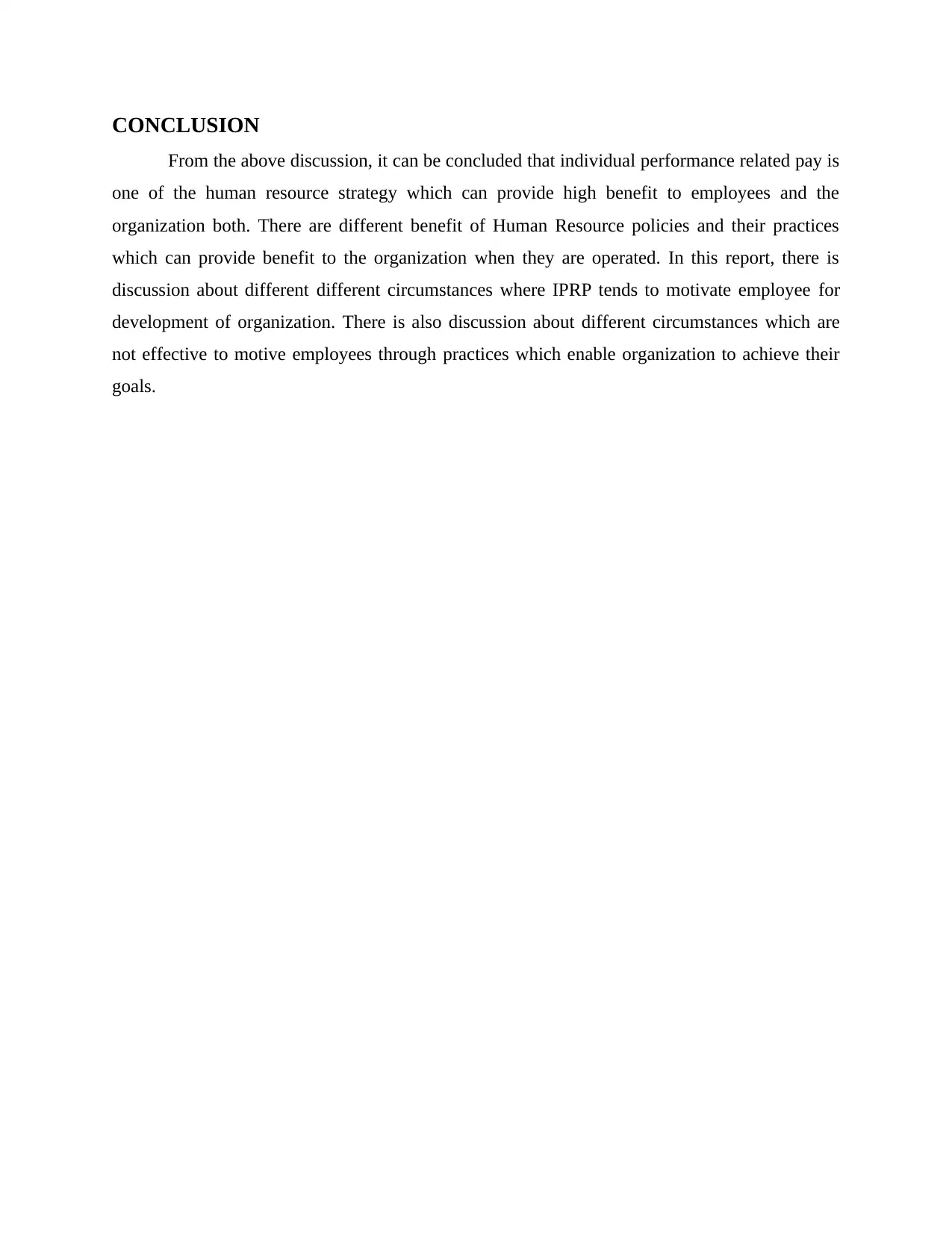
CONCLUSION
From the above discussion, it can be concluded that individual performance related pay is
one of the human resource strategy which can provide high benefit to employees and the
organization both. There are different benefit of Human Resource policies and their practices
which can provide benefit to the organization when they are operated. In this report, there is
discussion about different different circumstances where IPRP tends to motivate employee for
development of organization. There is also discussion about different circumstances which are
not effective to motive employees through practices which enable organization to achieve their
goals.
From the above discussion, it can be concluded that individual performance related pay is
one of the human resource strategy which can provide high benefit to employees and the
organization both. There are different benefit of Human Resource policies and their practices
which can provide benefit to the organization when they are operated. In this report, there is
discussion about different different circumstances where IPRP tends to motivate employee for
development of organization. There is also discussion about different circumstances which are
not effective to motive employees through practices which enable organization to achieve their
goals.
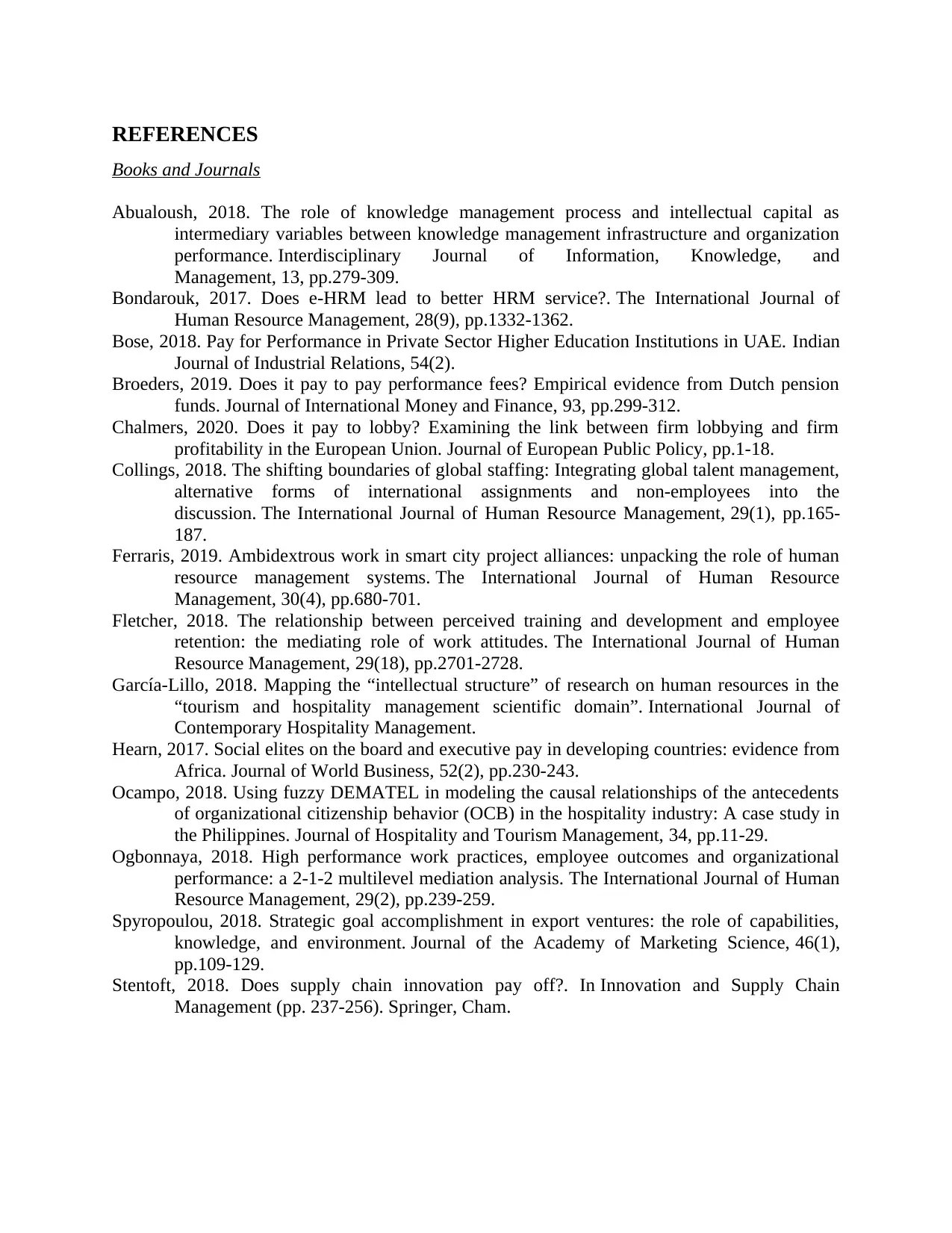
REFERENCES
Books and Journals
Abualoush, 2018. The role of knowledge management process and intellectual capital as
intermediary variables between knowledge management infrastructure and organization
performance. Interdisciplinary Journal of Information, Knowledge, and
Management, 13, pp.279-309.
Bondarouk, 2017. Does e-HRM lead to better HRM service?. The International Journal of
Human Resource Management, 28(9), pp.1332-1362.
Bose, 2018. Pay for Performance in Private Sector Higher Education Institutions in UAE. Indian
Journal of Industrial Relations, 54(2).
Broeders, 2019. Does it pay to pay performance fees? Empirical evidence from Dutch pension
funds. Journal of International Money and Finance, 93, pp.299-312.
Chalmers, 2020. Does it pay to lobby? Examining the link between firm lobbying and firm
profitability in the European Union. Journal of European Public Policy, pp.1-18.
Collings, 2018. The shifting boundaries of global staffing: Integrating global talent management,
alternative forms of international assignments and non-employees into the
discussion. The International Journal of Human Resource Management, 29(1), pp.165-
187.
Ferraris, 2019. Ambidextrous work in smart city project alliances: unpacking the role of human
resource management systems. The International Journal of Human Resource
Management, 30(4), pp.680-701.
Fletcher, 2018. The relationship between perceived training and development and employee
retention: the mediating role of work attitudes. The International Journal of Human
Resource Management, 29(18), pp.2701-2728.
García-Lillo, 2018. Mapping the “intellectual structure” of research on human resources in the
“tourism and hospitality management scientific domain”. International Journal of
Contemporary Hospitality Management.
Hearn, 2017. Social elites on the board and executive pay in developing countries: evidence from
Africa. Journal of World Business, 52(2), pp.230-243.
Ocampo, 2018. Using fuzzy DEMATEL in modeling the causal relationships of the antecedents
of organizational citizenship behavior (OCB) in the hospitality industry: A case study in
the Philippines. Journal of Hospitality and Tourism Management, 34, pp.11-29.
Ogbonnaya, 2018. High performance work practices, employee outcomes and organizational
performance: a 2-1-2 multilevel mediation analysis. The International Journal of Human
Resource Management, 29(2), pp.239-259.
Spyropoulou, 2018. Strategic goal accomplishment in export ventures: the role of capabilities,
knowledge, and environment. Journal of the Academy of Marketing Science, 46(1),
pp.109-129.
Stentoft, 2018. Does supply chain innovation pay off?. In Innovation and Supply Chain
Management (pp. 237-256). Springer, Cham.
Books and Journals
Abualoush, 2018. The role of knowledge management process and intellectual capital as
intermediary variables between knowledge management infrastructure and organization
performance. Interdisciplinary Journal of Information, Knowledge, and
Management, 13, pp.279-309.
Bondarouk, 2017. Does e-HRM lead to better HRM service?. The International Journal of
Human Resource Management, 28(9), pp.1332-1362.
Bose, 2018. Pay for Performance in Private Sector Higher Education Institutions in UAE. Indian
Journal of Industrial Relations, 54(2).
Broeders, 2019. Does it pay to pay performance fees? Empirical evidence from Dutch pension
funds. Journal of International Money and Finance, 93, pp.299-312.
Chalmers, 2020. Does it pay to lobby? Examining the link between firm lobbying and firm
profitability in the European Union. Journal of European Public Policy, pp.1-18.
Collings, 2018. The shifting boundaries of global staffing: Integrating global talent management,
alternative forms of international assignments and non-employees into the
discussion. The International Journal of Human Resource Management, 29(1), pp.165-
187.
Ferraris, 2019. Ambidextrous work in smart city project alliances: unpacking the role of human
resource management systems. The International Journal of Human Resource
Management, 30(4), pp.680-701.
Fletcher, 2018. The relationship between perceived training and development and employee
retention: the mediating role of work attitudes. The International Journal of Human
Resource Management, 29(18), pp.2701-2728.
García-Lillo, 2018. Mapping the “intellectual structure” of research on human resources in the
“tourism and hospitality management scientific domain”. International Journal of
Contemporary Hospitality Management.
Hearn, 2017. Social elites on the board and executive pay in developing countries: evidence from
Africa. Journal of World Business, 52(2), pp.230-243.
Ocampo, 2018. Using fuzzy DEMATEL in modeling the causal relationships of the antecedents
of organizational citizenship behavior (OCB) in the hospitality industry: A case study in
the Philippines. Journal of Hospitality and Tourism Management, 34, pp.11-29.
Ogbonnaya, 2018. High performance work practices, employee outcomes and organizational
performance: a 2-1-2 multilevel mediation analysis. The International Journal of Human
Resource Management, 29(2), pp.239-259.
Spyropoulou, 2018. Strategic goal accomplishment in export ventures: the role of capabilities,
knowledge, and environment. Journal of the Academy of Marketing Science, 46(1),
pp.109-129.
Stentoft, 2018. Does supply chain innovation pay off?. In Innovation and Supply Chain
Management (pp. 237-256). Springer, Cham.
⊘ This is a preview!⊘
Do you want full access?
Subscribe today to unlock all pages.

Trusted by 1+ million students worldwide
1 out of 9
Related Documents
Your All-in-One AI-Powered Toolkit for Academic Success.
+13062052269
info@desklib.com
Available 24*7 on WhatsApp / Email
![[object Object]](/_next/static/media/star-bottom.7253800d.svg)
Unlock your academic potential
Copyright © 2020–2025 A2Z Services. All Rights Reserved. Developed and managed by ZUCOL.


